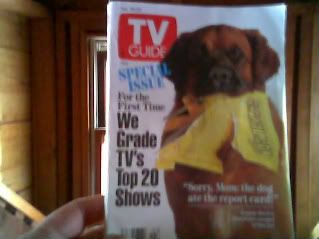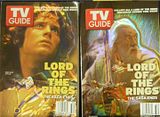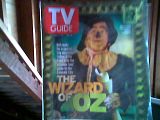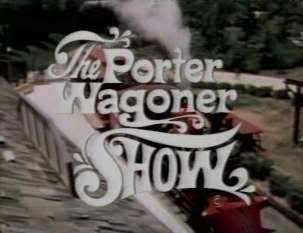Hee-Haw had a lot of merchandising during it's early years. There were lunch boxes and comic books and a magazine. The show also became popular for some of the women cast-members, known collectively as the Hee-Haw Honey's. Through all of my years watching the show and knowing of the show I can say that there was never anything blatantly off-color or dirty when it came to the Hee-Haw Honey aspect...there was and there's always been a critical disdain for the show as a whole because of it becoming a hit. Country music itself was never really considered mainstream to begin with...and here you had a TV program reaching millions of people each week not only spotlighting country music, but also bluegrass and gospel in addition to the corny jokes...there were a lot of people angry that the show was a success.
And so, male viewers no doubt appreciated seeing the women on the show...there was a look to a Hee-Haw Honey...each of them wore usually the same style of clothing: short shorts and tight t-shirts. This was several years before
Dukes of Hazzard came along so they weren't called 'Daisy Dukes' at the time...but you get the idea. Gunilla Hutton, Misty Rowe, Lisa Todd, Linda Thompson, Jeannine Riley, and Marianne Rogers were the more notable of the Hee-Haw Honey's although just about all of the women were put under the Honey umbrella. The women who were not considered a "Honey" were Roni Stoneman, Minnie Pearl, and Lulu Roman...these women were mostly cast as eccentric or bizarre characters and not known or thought of as eye candy...whereas with Minnie, she played the role she'd been playing at the Opry for years as the older woman trying to find a companion.
Barbi Benton was on the program in the early to mid 1970's. She is more widely known for her Playboy-related appearances instead of being a Hee-Haw Honey given her connection to Hugh Hefner. She was Hefner's girlfriend for eight years...Barbi left Hee-Haw in 1976, the same year she and Hefner broke up...and she continued to appear in various TV programs throughout the 1970's and 1980's.
As for Linda Thompson, she was once a part of Elvis Presley's inner circle...she was his girlfriend during his later years. You can look her images up on-line and see a lot of pictures of her taken at Graceland.
She was married to Bruce Jenner in the early '80s and in the episodes of the show in the early 1980's she's referred to as Linda Thompson-Jenner and she was also married to David Foster, having married him in 1991, but she separated from him in 2005. Linda was on the show from 1976 through 1992.
Linda's recurring skit involved playing the daughter of Kenny Price. The routine often started showing a haystack and you'd hear a lazy harmonica playing and Linda would sigh "Paw..." and Kenny, usually raking hay, would turn and say something like "yes, daughter" and she'd go on to him about her problems with her boyfriend, known as Billy Bob. By the end of the routine she'd slip out some sort of secret and go "oops" to which Kenny would storm off huffing and puffing saying things like "
i'm gonna kill him!".
Linda, as well as other Honey's, were often seen in a routine known just as "the Haystack" where the camera would show the shot of a haystack and then drop down to show one of the Honey's and usually Jim or Jon Hager...sometimes Buck Owens...acting as a boyfriend to one of the Honey's of the show.
Irlene Mandrell was one of the Hee-Haw Honey's as well. On the show she typically played the Kornfield Kounty telephone operator. She could also be seen in the All-Jug band and for a short period of time she was one of the women in the exercise skit where a few women would be shown exercising and telling jokes back and forth. Irlene was on the show from 1984 to 1992.
The Hee-Haw Honey's were spun off into their own program, titled obviously "The Hee-Haw Honeys". In this series several of the show's cast played character's with the last name of Honey. Kathie Lee Gifford, not a part of the Hee-Haw show, was cast in this series. She played Kathie Honey. Gailord Sartain was on the show as Willie Billy Honey. Kenny Price and Lulu Roman were like the parental figures. The show ran for one season.
Lulu was one of the big parts of the show. In addition to her being in The Culhanes skit she was also in the All-Jug band plus she was often one of the gossipers in the Rumors skit. Her signature skit was "Lulu's Truckstop" where she played a sassy waitress and Gailard Sartain played the cook/romantic interest, Orville. The food served there was awful...in one scene in a later episode Dub Taylor complained that just being in the place was giving him indigestion before having eaten anything.
Another aspect of this series were the animated animals that often popped up on screen. In addition to the animated donkey which appeared at the start and close of every episode you also had various farm animals that would comment on the jokes being told. A duck or a pig would hold up signs reacting to the joke...much like the coyote in the Road Runner cartoons. They often used a cow or a donkey as commercial bumpers, too. A goat was often seen chewing up the show's title only for him to hiccup and the title would be shown in reverse and then he'd look at the camera and go "Hee-Haw will be right ba-a-a-a-c-c-c-k!". If the show ran bloopers, for example, they'd show a cow holding up a sign reading "they're milking this joke". Bloopers often happened as part of the cornfield segment when people would pop up and start to talk but mess up their lines...in Junior's case he couldn't pronounce a lot of big words and so they'd tape him trying to say all kinds of words and insert it into the show. In one example, Grandpa Jones broke a string on his banjo while taping a performance. On any other show this scene would never have made it on the air...but on Hee-Haw not only was the blooper shown, but the camera taped Grandpa fumbling with the banjo and arguing with it as he put a new string on it.
When Reverend Grady Nutt was a cast-member, he'd tell stories inside Archie Campbell's barbershop set. After his skit was through, typically you'd see the scene cut to an animated donkey holding up a sign that read "Let us Bray". Of course, a lot of acts got the dancing pig treatment. if a song was a sing-a-long or if one of the show's own cast-members were performing a song, it wasn't uncommon to see a row of dancing pigs come dancing along the screen kicking their legs. This happened during a Hank Williams, Jr song...another instance was when Kenny Price was singing "Crawdad Hole".
In addition to the Hee-Haw gospel quartet, the show also featured the Million Dollar Band. This segment would become a fan-favorite as well...it included Roy Clark, Chet Atkins, Johnny Gimble, Floyd Cramer, Boots Randolph, Jethro Burns, and Danny Davis. Charlie McCoy, the show's musical director and a harmonica player, was often featured in music pieces like this, as well, where only music was played, no singing.
The Hee-Haw Salute was one of the recurring routines that would appear twice or three times during a show. Roy Clark or Buck Owens during the early episodes would mention a city or town in America and salute it...sometimes this was done for comedy and they would spotlight a town with a population of 28 or something. The routine would go something like this:
Hee-Haw salutes Dusty Trail, Texas; population 58Then the camera would pan to the cornfield where everyone would in unison holler "SALUTE!" but in rural speech it would sound like "SA-LOOT!". Not all of the salute's would be comical...some towns were major cities with thousands and thousands of people. Also, personalities from local TV stations that aired Hee-Haw would stop by for a visit and the local town was saluted in that segment.
The great cast shake up of 1986 was when the show let go a lot of their cast-members except a handful. Buck Owens was not among those being let go but he wanted out of the show and so when the 1986 season opened up, there was no Buck Owens as co-host. Instead, the show began a policy of guest co-hosts each week with Roy Clark. The guest co-host or co-hosts depending on if it were a duo, would fill-in during Buck Owens' routines...the sing-a-long's and musical numbers that had become fan favorites. This guest co-host policy remained until the end of the 1989-1990 season. Afterward, Roy hosted the show by himself, 1990-1992.
Changes were made throughout 1986-1988 and a lot of it had to do with the deaths of two long-running cast-members: Kenny Price and Archie Campbell. The two of them passed away in 1987...so that was two more losses, in addition to the others who were let go in 1986, in addition to Buck leaving the cast. The show continued on just as before...largely due to the fact that a lot of recurring skit's and routines were being inserted into the show with more frequency...with the Hee-Haw Salute, for example, airing up to four times throughout one episode...Roy's quick "Empty Arms Hotel" skit would sometimes air three times during the hour...but then there were some new skits popping up every so often, too. Kenny Price passed away between production cycles and so he continued to be featured as a cast-member into 1988 with material he taped before his death.
The cast members let go in 1986 were Don Harron, Lisa Todd, The Hager Twins, and without Buck Owens as a co-host his back-up group, The Buckaroos, left the show in 1986 as well. Jackie Phelps passed away and so he of course was no longer featured on the show from 1986 onward. Jackie had been featured as the bartender in the "Hee-Haw Honky Tonk" skit plus in the early years he was a comedy partner of Jimmy Riddle, the two of them billed on the show as Riddle and Phelps.
Critics and historians like to say that Hee-Haw was losing their audience during 1990-1991 in a way that suggests viewers were tuning the show out but I say the show never lost it's audience voluntarily...I believe the show lost affiliate stations, and that would drive audience numbers down because less people were seeing the show than before. Here where I live the local stations stopped airing the show in 1991...so I never got to see the last season. I know some area's stopped carrying the show in 1990 and some in 1989...so with stations dropping the program it's no wonder ratings started to suffer...but I don't believe audiences were turning the show off themselves as critics would have you believe.
The producers of the show, amidst station loss and the stunning sales hikes of country music in the early 1990's with it's rock/pop overtones, had no choice but to revamp the program because for the first time in the show's history it's rural imagery and purposely cornball approach was seen as more hurtful than helpful by a whole host of "new country" singers popping up during this time period refusing to appear on the show because of it's "look" and potentially harmful effect an appearance could have on their career. About the show's look: an episode from 1991 could easily be shown back-to-back with a show from 1981...the look and formula of the show was
that consistent year after year.
Several new additions came to the show during the 1989-1990 season and in 1990, Phil Campbell joined the show. After the 1990-1991 season wrapped up, word was sent that everyone except a few were going to be dropped from the show. Those who were dropped from the show were many: Roni Stoneman, Marianne Rogers, Cathy Baker, Dub Taylor, Mike Snider, Jeff Smith, Vicki Byrd, Misty Rowe, Terry Sanders, Minnie Pearl. Dub Taylor came aboard in 1985 while Jeff Smith came along in 1984 and Mike Snider joined the show in 1987. Vicki Byrd had joined the show in 1989 playing the quirky, confused type. Minnie Pearl had been a part of the show since 1971...Roni Stoneman was another long-time cast member let go as were Gunilla Hutton, Misty Rowe, and Marianne Rogers. Williams and Ree, a comedy duo who gained their popularity on The Nashville Network, was a part of the show during 1989-1991. Terry Sanders was often seen in Minnie's "Grinders Switch Gazette" skit playing an office boy...his tenure on the show was 1989-1991 as well. The last episode of the
old Hee-Haw as fans refer to it was in July 1991.
You may be asking...with so many cast members let go at the end of the 1991 season, who was left? There were a few people left standing plus they brought in newcomers...
Roy Clark remained as the show's host. Grandpa Jones, Gordie Tapp, Lulu Roman, George Lindsay, Irlene Mandrell, Linda Thompson, Gailard Sartain, Charlie McCoy, and Phil Campbell all returned in 1992.
The new additions were unknowns pretty much. Gary Mule Deer, one of the new cast-members, gained some fame as a stand-up comedian. There was also a pair of women known as The Norris Twins...and some others...but they never aired the program in wide distribution so I can't make a decision either way since I'd never seen any of the 1992 episodes...but with the cornfield gone and other parts of the show that were fan favorites eliminated, I don't believe the program should have kept the name of Hee-Haw since the very name of the show suggested country life, cornfields, donkeys, haystacks, etc etc.
The 1992 episodes, which began airing in January 1992, were not aired here but from what I read, the episodes angered the viewers who didn't want to see these changes and wanted the "old Hee-Haw" back. Sam Lovullo recounts this period in time and the entire show from start to finish in his book,
Life in the Kornfield.
After these 1992 episodes aired and were repeated, the show went out of production for good...re-runs of the show returned in the fall of 1992 under the name of "Hee-Haw Silver". These special episodes were designed to commemorate the program's 25th season on the air.
There were 52 episodes of this Silver series...each hosted by Roy Clark and featuring Cathy Baker aired during the 1992-1993 television season. Afterward, the show became an on-again/off-again show for TNN and later, CMT. On TNN they aired reruns on a frequent basis: Saturday nights at 10pm following "The Statler Brothers Show". Ultimately, though, the reruns were taken off the air and shifted to CMT...and it's here that the show aired infrequently. Time Life got into the act around this time...they had begun promoting a VHS home video called
Hee-Haw Laffs during the show's rerun life on TNN. An Opryland production called
Hee-Haw Live had been a success during this same time period. The VHS compilation arrived in 1996...the show continued to pop-up in reruns on TNN and later, CMT, through 1998 when it appeared to have aired for a final time...but fast-forward a decade to 2008...
By this time the show had become a sales success on Time Life through a series of DVD's...and RFD-TV took notice of the audience that the show continued to pull in. One of the unique things about Hee-Haw today is a lot of the fans of the show are young people who had often heard about the show from their parents or grandparents and checked the show out for themselves through the DVD's and various clips that appear on video hosting sites. No doubt the dated look appeals to nostalgia buffs; and, the personalities who starred on the show and the guests have some historical value among country music circles. Some of this latter-day praise is for it's simplicity as compared to the complex and complicated forms of entertainment on TV now...others simply find the show fascinating to watch...remember, the under 30 crowd of today were barely into their teens when the show was leaving the air...so there's not a nostalgia feel for the show from that age-group. I first saw the show when I was 5 or 6...it was the early 1980's. I grew up with this show in the background...every Saturday was Hee-Haw at 7pm.
The program is currently airing in reruns on the RFD-TV channel. The air-time is 8pm Sunday nights and it repeats at 10am Monday mornings. There have been a series of DVD's released by Time Life of the program as I made mention of...so for those who want to have some of the episodes in your personal collection you should seek the DVD's out until RFD-TV becomes more available.
Hee-Haw: 1969-1992.
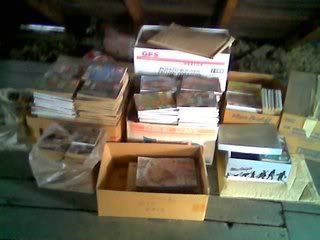 I have a somewhat modest collection of TV Guide. The issues you see in the above picture are sitting up in my grandparent's attic. I especially like the way the pages have aged...it gives them that "old" look. I ran out of place to store them in my bedroom over there and so I boxed and sacked up a lot of them and put them up in the attic. I have issues that date back to the mid 1970's and some from the 1980's that I bought on-line at auction sites and some i've bought at flea markets off-line but the bulk of my modest collection starts up in 1991...from that point forward I have just about every issue up through 2005/2006...14 to 15 years worth of TV Guide. I wish I had more older issues, though...but I'm happy with what older issues I do have from the '70s and '80s.
I have a somewhat modest collection of TV Guide. The issues you see in the above picture are sitting up in my grandparent's attic. I especially like the way the pages have aged...it gives them that "old" look. I ran out of place to store them in my bedroom over there and so I boxed and sacked up a lot of them and put them up in the attic. I have issues that date back to the mid 1970's and some from the 1980's that I bought on-line at auction sites and some i've bought at flea markets off-line but the bulk of my modest collection starts up in 1991...from that point forward I have just about every issue up through 2005/2006...14 to 15 years worth of TV Guide. I wish I had more older issues, though...but I'm happy with what older issues I do have from the '70s and '80s.